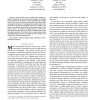Free Online Productivity Tools
i2Speak
i2Symbol
i2OCR
iTex2Img
iWeb2Print
iWeb2Shot
i2Type
iPdf2Split
iPdf2Merge
i2Bopomofo
i2Arabic
i2Style
i2Image
i2PDF
iLatex2Rtf
Sci2ools
HICSS
2003
IEEE
2003
IEEE
Designs for Ramp-Constrained Day-Ahead Auctions
— Some electric power markets allow bidders to specify constraints on ramp rates for increasing or decreasing power production. We show in a small example that a bidder could use an overly restrictive constraint to increase profits, and explore the cause by visualizing the feasible region from the linear program corresponding to the power auction. We propose two penalty approaches to discourage bidders from such a tactic: one based on duality theory of Linear Programming, the other based on social cost differences caused by ramp constraints. We evaluate the two approaches using a simplified scaled model of the California power system, with actual 2001 California demand data.
Biometrics | California Power System | HICSS 2003 | Markets Allow Bidders | Ramp Rates | System Sciences |
| Added | 04 Jul 2010 |
| Updated | 04 Jul 2010 |
| Type | Conference |
| Year | 2003 |
| Where | HICSS |
| Authors | Shmuel S. Oren, Andrew M. Ross |
Comments (0)

